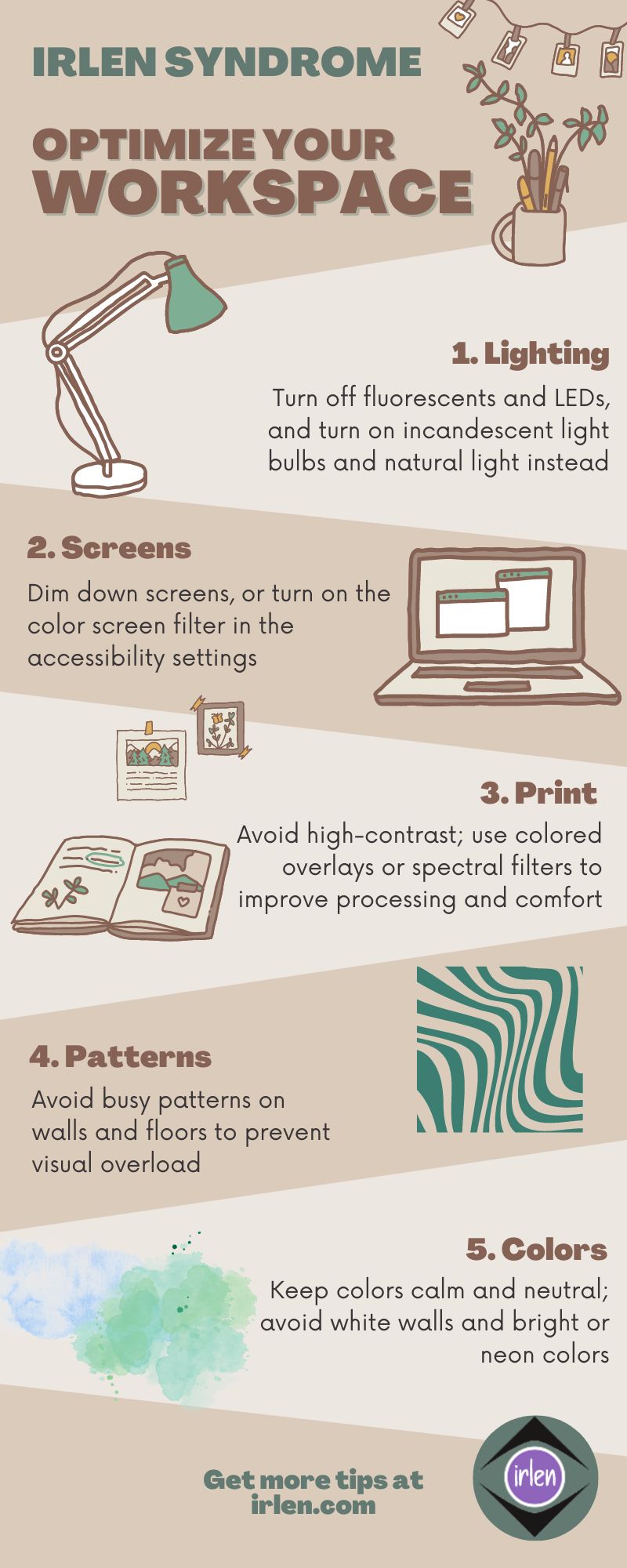
Irlen Syndrome is more common than either heart disease or asthma but is often overlooked as the possible cause of the learning challenges many children face. This visual processing problem causes a variety of symptoms from visual distortions that make academic work more challenging to physical symptoms like headaches, migraines, strain and fatigue, difficulty attending, and problems with depth perception. Certain environments and situations, such as bright and fluorescent lighting, can make symptoms worse, and symptoms can be different in different people. Understanding the depth and breadth of the impact Irlen Syndrome can have is key to successfully addressing the condition and removing it as a barrier to learning. A short pre-screening questionnaire can help identify individuals who might be at risk for Irlen Syndrome, and educators can be trained to both identify and address Irlen Syndrome in their students.
In Irlen Syndrome, the brain struggles to make sense of the visual information it receives. Symptoms of the condition can range from mild discomfort under fluorescent lights and eye strain from the glare off the printed page to severe distortions on the page and in the environment and daily migraine headaches. Irlen Syndrome can be a contributing factor in up to 46% of children with reading and learning difficulties, and approximately 30% of people with ADHD, dyslexia, autism, and those who have suffered a head injury. It also affects 12-14% of the general population, people who don’t have learning problems, successful professionals, and gifted students.
Overcoming Common Misconceptions
Since the condition was first discovered by American Psychologist, Helen Irlen, in 1983, several misconceptions about the condition have surfaced.
Misconception #1: Irlen Syndrome is just about reading. It’s not. Irlen Syndrome is a neurologic condition resulting in an over-active or over-stimulated brain. This extra brain activity affects lots of different areas of functioning including health and well-being, attention, concentration, behavior, depth perception, and academic performance. The impact on academic performance isn’t restricted to reading; the condition can also affect math computation, handwriting, copying, and even listening. It can affect behavior in the classroom, how long a child can stay focused, and how quickly a child can get work done. It can also have a dramatic effect on how a child feels physically. It can cause headaches, migraines, nausea, fatigue, and anxiety, and sometimes these physical symptoms can be debilitating. It’s not just about being able to see words clearly.
Misconception #2: Irlen Syndrome is a problem with the eyes. Wrong. Irlen Syndrome is not an issue with the eyes, it’s a problem with the brain. Even when the eyes function perfectly, the brain can have difficulty processing the visual information it receives. Irlen Syndrome requires separate and distinct assessment and intervention from eye problems. Vison issues should always be addressed by a trained eye-care professional prior to assessing a student for Irlen Syndrome.
Misconception #3: If a student is struggling to read, it’s probably dyslexia. Not necessarily. Dyslexia is one condition that can result in difficulty reading, but it’s not the only thing that can cause reading challenges. In fact, comments about physical discomfort when reading (e.g., eye strain or headaches), or print instability (e.g., words moving, blurring, etc.) are strong indicators that Irlen Syndrome might be the problem instead of dyslexia which is a phonological processing problem that is not related to physical symptoms or visual distortions. It is also possible for a student to have both dyslexia and Irlen Syndrome.
Co-Existing With Other Conditions: Autism, ADHD, Dyslexia, TBI
The latest research on Irlen Syndrome has moved beyond reading to look at other populations. As many as 80% of individuals on the autism spectrum report having distorted perception, and research on Irlen Syndrome and autism has shown that interventions for Irlen Syndrome successfully correct this distorted world to make it clear and stable. The same is true for individuals struggling with headaches, reading, and academic difficulties after a concussion or head injury. When it comes to the connection between Irlen Syndrome and ADHD and Dyslexia, up to 30% of individuals who have these conditions also suffer from Irlen Syndrome. Sometimes there is a misdiagnosis of ADHD or dyslexia when the true problem is Irlen Syndrome.
Addressing Irlen Syndrome is Easy and Immediate
Irlen Syndrome is extremely easy to identify and address if you know what to look for. A brief questionnaire can be administered to a group of students, or individually, to flag students whose difficulties are likely to be a result of Irlen Syndrome. Once students are identified and assessed by a trained professional, eliminating Irlen Syndrome as a barrier to learning is simple and immediate through the use of individualized, precision-tinted colored filters and overlays. Brain imaging research shows how filtering visual information through individualized spectral filters calms and normalizes brain activity in individuals with Irlen Syndrome, improving their performance and ability to function. Learn more about solutions.
For more information about Irlen Syndrome and a pre-screening self-test, visit www.irlensyndrome.org and www.irlen.com.





 Saccadic movement, more commonly known as saccades, is the ability of the eyes to move in synchrony from point A to point B rapidly without deviating from the path. Impaired saccadic movement is when the eyes do not move together in a designated pattern such as left/right and top/bottom. They may jump randomly or move in uncoordinated patterns that can lead to a variety of issues when completing reading and written work.
Saccadic movement, more commonly known as saccades, is the ability of the eyes to move in synchrony from point A to point B rapidly without deviating from the path. Impaired saccadic movement is when the eyes do not move together in a designated pattern such as left/right and top/bottom. They may jump randomly or move in uncoordinated patterns that can lead to a variety of issues when completing reading and written work.


